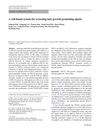Fabrication and Characterization of Electrospun Membranes Based on “Poly(ε-caprolactone)”, “Poly(3-hydroxybutyrate)” and Their Blend for Tunable Drug Delivery of Curcumin
September 2020
in “
Polymers
”
TLDR The PCL/PHB blend allows for slower, more controlled curcumin release than individual polymers.
The study investigated the fabrication and characterization of electrospun membranes made from poly(ε-caprolactone) (PCL), poly(3-hydroxybutyrate) (PHB), and their blend for controlled drug delivery of curcumin. The PCL/PHB blend showed a more controlled and slower release of curcumin compared to individual polymers, due to weak intermolecular bonds that increased mass transfer resistance. The blend exhibited a double-step release phenomenon, reaching a plateau after 400 hours, while pure polymers released completely after about 128 hours. The blend also had improved mechanical and barrier properties, suggesting its potential for tunable drug delivery in biomedical applications.
